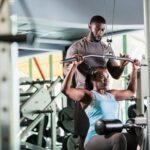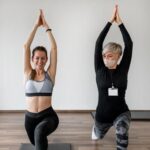Are you looking to improve your fitness but find it challenging to make it to the gym? Home fitness routines can be a convenient and effective solution for staying active and healthy. In this article, we will explore the importance of incorporating home fitness routines into your lifestyle, as well as provide tips and guidance for beginners and experienced exercisers alike.
When it comes to maintaining a consistent exercise regimen, having the option to work out at home can make all the difference. Whether you’re short on time, prefer privacy, or simply enjoy the convenience of exercising in your own space, home fitness routines offer a flexible and accessible way to stay fit. From setting up a dedicated workout area to incorporating a variety of exercises, there are numerous benefits to creating a personalized fitness routine at home.
In the following sections, we will discuss how to set up your home gym with the necessary equipment and space requirements. We’ll also cover beginner-friendly workouts for those new to exercising at home, as well as more advanced routines for seasoned fitness enthusiasts.
Additionally, we’ll provide tips for creating a schedule, staying motivated, and adding variety to your home workouts. Whether you’re considering ditching your gym membership or simply looking for ways to supplement your current routine, embracing home fitness can be a rewarding and fulfilling choice for anyone looking to prioritize their health and wellness.
Setting Up Your Home Gym
When setting up your home gym, it’s important to consider the equipment and space requirements to ensure that you have everything you need for a successful home fitness routine. Creating a dedicated space for your workouts can help you stay motivated and focused on your fitness goals.
Equipment Requirements
Before starting your home fitness routine, take inventory of the equipment you already have. Depending on your workout preferences, you may need basic items such as dumbbells, resistance bands, yoga mat, jump rope, or a stability ball. If you’re into cardio workouts, consider investing in a treadmill or stationary bike. For strength training, adjustable dumbbells or a multi-purpose weight bench could be beneficial.
Space Requirements
When deciding where to set up your home gym, consider a space that is well-ventilated and has enough room for movement. A spare room, garage, or even a corner of your living room can be transformed into an effective workout area. Make sure there’s enough space for stretching exercises, as well as storage for your equipment to keep the area tidy and organized.
Budget-Friendly Options
If you’re on a budget or short on space, there are still plenty of options for setting up a home gym. Look for versatile equipment that can be easily stored when not in use, such as resistance bands, adjustable dumbbells, or compact exercise machines. Additionally,you can also incorporate bodyweight exercises that require no equipment at all.
By considering both the equipment and space requirements for your home gym setup, you can create an environment that caters to your fitness needs and ensures consistent adherence to your home fitness routines.
The Best Home Fitness Routines for Beginners
Starting a home fitness routine can be an exciting yet daunting task, especially for beginners. To ease into a new workout regimen, it’s important to start with exercises that are beginner-friendly and can help build strength and endurance.
One of the best home fitness routines for beginners is a full-body workout that incorporates bodyweight exercises such as squats, lunges, push-ups, and planks. These exercises not only help build muscle but also improve flexibility and balance. Additionally, incorporating simple equipment like resistance bands or dumbbells can add variety to the routine.
Another effective home fitness routine for beginners is cardio-based workouts such as brisk walking, jogging in place, or jumping jacks. These activities help elevate the heart rate, improve cardiovascular health, and are perfect for those who are just starting their fitness journey.
In addition to these routines, it’s essential for beginners to focus on proper form and technique to prevent injury and ensure effectiveness. It’s also important to start slow and gradually increase intensity as fitness levels improve.
| Home Fitness Routine | Description |
|---|---|
| Full-Body Workout | Incorporate bodyweight exercises such as squats, lunges, push-ups, and planks along with simple equipment like resistance bands or dumbbells. |
| Cardio-Based Workouts | Include activities like brisk walking, jogging in place, or jumping jacks to elevate heart rate and improve cardiovascular health. |
Advanced Home Fitness Routines for Experienced Exercisers
For experienced exercisers, home fitness routines can provide an opportunity to elevate their workouts and achieve their fitness goals in the comfort of their own space. Advanced home fitness routines often involve a combination of strength training, cardio, and flexibility exercises to challenge the body and prevent plateauing. With the right equipment and knowledge, advanced exercisers can create intense and effective workouts at home.
One of the key components of an advanced home fitness routine is incorporating weight training. Investing in a set of dumbbells or kettlebells can open up a world of possibilities for strength-focused workouts. Exercises such as squats, lunges, deadlifts, and overhead presses can be performed with these weights to build muscle and improve overall strength. Additionally, resistance bands are a versatile and affordable tool that can be used for various upper and lower body exercises.
In addition to strength training, advanced exercisers can incorporate high-intensity interval training (HIIT) into their home fitness routines. HIIT involves short bursts of intense exercise followed by brief periods of rest or low-intensity activity.
This type of workout is known for its ability to burn calories effectively and improve cardiovascular endurance. With the use of a jump rope, stationary bike, or even just bodyweight exercises like burpees and mountain climbers, advanced individuals can tailor HIIT workouts to suit their preferences and fitness levels.
| Equipment | Routines |
|---|---|
| Dumbbells | Strength-focused workouts incorporating squats, lunges, deadlifts etc. |
| Resistance bands | Versatile tool for upper and lower body exercises |
| Jump rope/Stationary bike | High-intensity interval training (HIIT) workouts |
Creating a Schedule for Home Fitness Workouts
When it comes to sticking to a home fitness routine, having a schedule in place can make all the difference. Just like any other commitment, scheduling your workouts and sticking to a consistent routine is key to seeing results and maintaining motivation. Here are some tips for creating a schedule for your home fitness workouts:
1. Determine the Best Time: Consider your daily routine and when you have the most energy and motivation. Whether it’s first thing in the morning, during lunch break, or in the evening, find a time that works best for you and stick to it.
2. Choose Your Workout Days: Decide how many days per week you want to dedicate to home fitness workouts. Depending on your schedule and fitness goals, aim for at least 3-5 days of exercise per week.
3. Mix Up Your Routine: Incorporate different types of workouts throughout the week to target different muscle groups and keep things interesting. For example, schedule cardio on Mondays, strength training on Wednesdays, and yoga or flexibility exercises on Fridays.
Once you’ve established your schedule, be sure to treat your home fitness workouts as non-negotiable appointments with yourself. By committing to a consistent schedule, you’ll be more likely to stay on track with your fitness goals while enjoying the convenience of exercising at home. Remember that flexibility is also important – if something comes up and you miss a workout, simply adjust your schedule and get back on track the next day.
Tips for Staying Motivated and Consistent With Home Fitness Routines
Staying motivated and consistent with home fitness routines can be a challenge, but with the right strategies, it is definitely achievable. Here are some tips to help you stay on track and continue making progress with your at-home workouts.
Set Realistic Goals
One of the keys to staying motivated with home fitness routines is to set realistic goals for yourself. Whether you want to lose weight, gain muscle, or improve your overall health, having specific and achievable goals can give you something to work towards. Break down your larger goals into smaller, manageable steps so that you can track your progress and celebrate your achievements along the way.
Find a Workout Buddy
Working out alone at home can sometimes feel isolating, so finding a workout buddy can help keep you motivated and accountable. Whether it’s a family member, friend, or virtual workout group, having someone to exercise with can make your home fitness routine more enjoyable and provide additional support when you need it.
Reward Yourself
Treat yourself for reaching milestones in your home fitness routine. Whether it’s buying a new piece of workout equipment, treating yourself to a spa day, or indulging in a favorite meal or activity, having rewards to look forward to can increase your motivation and make sticking to your routine more enjoyable.
By implementing these tips into your home fitness routine, you will be able to maintain consistency and motivation in achieving your fitness goals from the comfort of your own home. Remember that staying on track may take time and effort but incorporating these strategies will ultimately lead to success in maintaining a healthy lifestyle through home fitness routines.
Incorporating Variety Into Your Home Fitness Routine
When it comes to home fitness routines, variety is key to keeping yourself motivated and engaged in your workouts. By changing up your exercises, you not only prevent boredom but also challenge different muscle groups, improve overall fitness, and reduce the risk of overuse injuries. Here are some ways you can easily incorporate variety into your home fitness routine:
1. Mix Up Your Workout Types: Instead of sticking to the same routine every day, try to include a mix of cardio, strength training, flexibility exercises, and balance workouts. This will not only keep things interesting but also ensure that you’re working on different aspects of your fitness.
2. Try Different Equipment: If you have a home gym set up, make use of various equipment such as dumbbells, resistance bands, stability balls, and kettlebells to add variety to your workouts. Even if you don’t have access to equipment, you can use household items like water bottles as weights or stairs for step-ups to change things up.
3. Explore Different Workout Styles: There are plenty of workout styles to choose from such as HIIT (High-Intensity Interval Training), Pilates, yoga, dance workouts, and more. Trying out different styles not only adds variety but also helps in developing different skills and techniques.
By incorporating variety into your home fitness routine with these simple tips, you can keep things exciting while reaping the benefits of a well-rounded workout regimen from the comfort of your own home. Whether you’re just starting out or have been exercising for years, mixing things up will help you stay on track with your fitness goals and prevent plateaus in progress.
The Benefits of Home Fitness Routines vs Gym Memberships
Many people often debate whether it is more beneficial to join a gym or to establish a home fitness routine. Both options have their advantages, but there are distinct benefits to choosing home fitness routines over gym memberships.
One of the primary advantages of home fitness routines is convenience. With a home gym, there is no need to commute to another location, which can save time and money. Additionally, having a dedicated space in the comfort of your own home allows for greater flexibility in scheduling workouts. Whether it’s early morning or late at night, you have the freedom to exercise whenever it best fits into your daily routine.
Another benefit of home fitness routines is privacy. Some individuals may feel self-conscious exercising in front of others, especially if they are just starting out on their fitness journey. Being able to work out at home can alleviate these feelings and provide a safe space for individuals to focus on their health and wellness without any external pressures.
Incorporating variety into your workouts is easier with home fitness routines as well. With access to a wide range of equipment and online workout resources available, individuals can mix up their exercises and try new routines without any additional cost.
This can help prevent boredom and plateaus in progress, keeping workouts engaging and effective over time. Ultimately, embracing the convenience and effectiveness of home fitness routines allows individuals to make consistent progress towards their health and wellness goals without the added pressure or expense of a traditional gym membership.
Conclusion
In conclusion, home fitness routines offer a convenient and effective way to stay in shape, improve overall health, and achieve personal fitness goals. By setting up a home gym with the necessary equipment and allocating space for workouts, individuals can easily incorporate regular exercise into their daily routine without the need to travel to a traditional gym.
Whether you are new to exercising or have years of experience, there are various home fitness routines that cater to individuals of all fitness levels.
Creating a schedule for home fitness workouts is essential for staying consistent and making progress. By incorporating beginner or advanced home fitness routines into your daily or weekly schedule, you can effectively target different muscle groups and work towards achieving specific fitness goals. Additionally, it is important to stay motivated and consistent with your home fitness routine by finding workout partners, tracking your progress, and rewarding yourself for reaching milestones.
Furthermore, home fitness routines provide the flexibility to incorporate variety into your workouts by trying different exercises, incorporating new equipment, or participating in online classes or challenges. This variety not only keeps your workouts interesting but also helps prevent plateaus while continually challenging your body. Ultimately, embracing the convenience and effectiveness of home fitness routines allows individuals to take control of their health and well-being without the added cost or time constraints associated with traditional gym memberships.
Frequently Asked Questions
What Is the Best Home Workout Program?
The best home workout program is one that fits your fitness goals, interests, and schedule. It should include a variety of exercises targeting strength, cardio, and flexibility. Online platforms like Beachbody or fitness apps offer comprehensive programs for all fitness levels.
What Are the Best Workouts to Do at Home?
When working out at home, it’s important to focus on exercises that don’t require much equipment. Bodyweight exercises like squats, lunges, push-ups, and planks are great options. Additionally, high-intensity interval training (HIIT) workouts and yoga routines can effectively target different muscle groups.
What Is a Good 7 Day Workout Plan at Home?
A good 7-day workout plan at home should include a mix of strength training, cardio, and rest days for recovery. For example, you could have three days of strength training (upper body, lower body, full body), two days of cardio (HIIT or steady-state), and two rest days to allow your muscles to recover and prevent burnout.

Passionate about providing useful information to anyone with an interest in the field of Personal Training, I strive to pass on to our readers quality information and to answer any questions about Personal Trainers, the work they do and how to become one.





